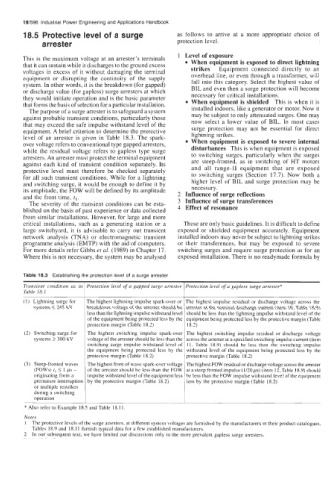Page 631 - Industrial Power Engineering and Applications Handbook
P. 631
18/596 Industrial Power Engineering and Applications Handbook
18.5 Protective level of a surge as follows to arrive at a more appropriate choice of
arrester protection level.
1 Level of exposure
This is the maximum voltage at an arrester’s terminals When equipment is exposed to direct lightning
that it can sustain while it discharges to the ground excess strikes
Equipment connected directly to an
voltages in excess of it without damaging the terminal overhead line, or even through a transformer, will
equipment or disrupting the continuity of the supply fall into this category. Select the highest value of
system. In other words, it is the breakdown (for gapped) BIL and even then a surge protection will become
or discharge value (for gapless) surge arresters at which necessary for critical installations.
they would initiate operation and is the basic parameter When equipment is shielded This is when it is
that forms the basis of selection for a particular installation.
The purpose of a surge arrester is to safeguard a system installed indoors, like a generator or motor. Now it
against probable transient conditions, particularly those may be subject to only attenuated surges. One may
now select a lower value of BIL. In most cases
that may exceed the safe impulse withstand level of the
equipment. A brief criterion to determine the protective surge protection may not be essential for direct
level of an arrester is given in Table 18.3. The spark- lightning strikes.
over voltage refers to conventional type gapped arresters, When equipment is exposed to severe internal
while the residual voltage refers to gapless type surge disturbances This is when equipment is exposed
arresters. An arrester must protect the terminal equipment to switching surges, particularly when the surges
against each kind of transient condition separately. Its are steep-fronted, as in switching of HT motors
protective level must therefore be checked separately and all range-I1 equipment that are exposed
for all such transient conditions. While for a lightning to switching surges (Section 17.7). Now both a
and switching surge, it would be enough to define it by higher level of BIL and surge protection may be
necessary.
its amplitude, the FOW will be defined by its amplitude 2 Influence of surge reflections
and the front time, t,. 3 Influence of surge transferences
The severity of the transient conditions can be esta-
blished on the basis of past experience or data collected 4 Effect of resonance
from similar installations. However, for large and more
critical installations, such as a generating station or a These are only basic guidelines. It is difficult to define
large switchyard, it is advisable to carry out transient exposed or shielded equipment accurately. Equipment
network analysis (TNA) or electromagnetic transient installed indoors may never be subject to lightning strikes
programme analysis (EMTP) with the aid of computers. or their transferences, but may be exposed to severe
For more details refer Gibbs et al. (1989) in Chapter 17. switching surges and require surge protection as for an
Where this is not necessary, the system may be analysed exposed installation. There is no readymade formula by
Table 18.3 Establishing the protection level of a surge arrester
Transient condition as in Protection level of a gapped surge arrester Protection level of a gapless surge arrester*
Table 18.1
(I) Lightning surge for The highest lightning impulse spark-over or The highest impulse residual or discharge voltage across the
systems I245 kV breakdown voltage of the arrester should be arrester at the nominal discharge current (item 10, Table 18.9)
less than the lightning impulse withstand level should be less than the lightning impulse withstand level of the
of the equipment being protected less by the equipment being protected less by the protective margin (Table
protection margin (Table 18.2) 18.2)
(2) Switching surge for The highest switching impulse spark-over The highest switching impulse residual or discharge voltage
systems 2 300 kV voltage of the arrester should be less than the across the arrester at a specified switching impulse current (item
switching surge impulse withstand level of 11, Table 18.9) should be less than the switching impulse
the equipment being protected less by the withstand level of the equipment being protected less by the
protective margin (Table 18.2) protective margin (Table 18.2)
(3) Steep-fronted waves The highest front of wave spark-over voltage The highest FOW residual or discharge voltage across the arrester
(FOWs) tl 5 1 ps - of thc arrcstcr should be less than the FOW at a steep fronted impulse (1/20 ps) (item 12, Table 18.9) should
originating from a impulse withstand level of the equipment less be less than the FOW impulse withstand level of the equipment
premature interruption by the protective margin (Table 18.2) less by the protective margin (Table 18.2)
or multiple restrikes
during a switching
operation
* Also refer to Example 18.5 and Table 18.1 1
Notes
1 The protective levels of the surge arresters, at different system voltages are Curnished by the manufacturers in their product catalogues,
Tables 18.9 and 18.11 furnish typical data for a few established manufacturers.
2 In our subsequent text, we have limited our discussions only to the more prevalent gapless surge arresters.

